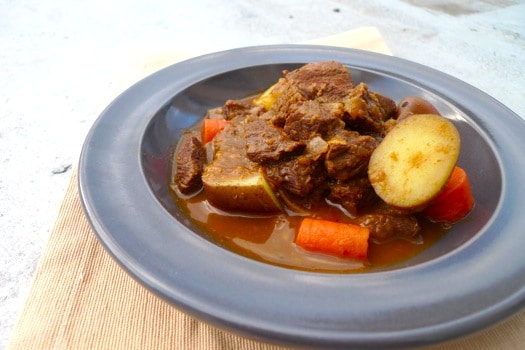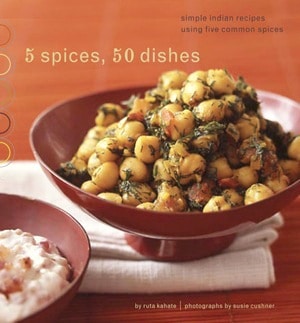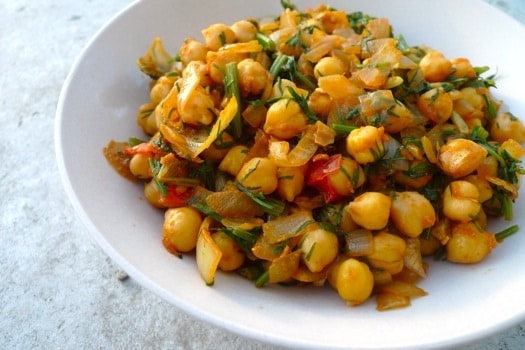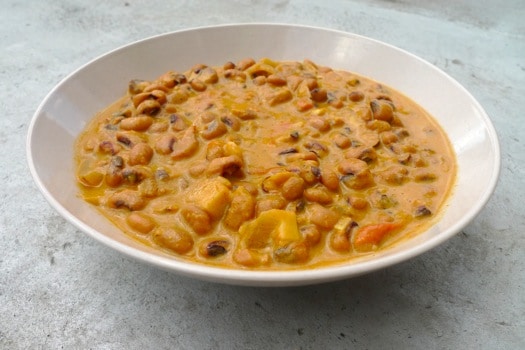This story starts with a bittersweet memory that still haunts me. When we moved into our apartment in San Francisco, one of the biggest selling points in my neighborhood were both a Japanese restaurant and an Indian restaurant within a few hundred feet. The week we moved in we noticed a sign on the Japanese restaurant saying that they would reopen in three weeks (it’s been well over a year, and they are still closed). And the Indian restaurant? It achieved a feat I thought impossible from south Asian cuisine: boring, bland, blah.
I desperately needed something to spice up my life, so to remedy things, I picked up a copy of Ruta Kahate’s 5 Spices, 50 Dishes at Omnivore Books. My attention was initially grabbed by the book’s aesthetics. Sometimes in life, you can judge a book by its cover. With it’s warm colors, pleasant font choices and thoughtful layout, I felt compelled to take it home with me.
A Great Indian Cookbook: 5 Spices, 50 Dishes
Within the first few minutes of flipping through its pages, I already had a mental list of dishes I wanted to try. The concept is fantastic: an entire repertoire of Indian dishes made with only five easily findable basic spices – coriander seeds, cumin seeds, mustard seeds, ground cayenne and ground turmeric. (The cookbook also happens to be color coded by spice, a useful design addition).
The author, Ruta Kahate, lives in the Bay Area where she leads Indian cooking classes, culinary tours of India and is dedicated to demystifying Indian flavors and bringing them into everyone’s kitchen. Throughout the cookbook her anecdotes evoke memories of a childhood in India, eating her mother’s cooking, traveling and developing a love for food. The writing is warm but spirited. ‘5 Spices, 50 Dishes’ is just as much a pleasure to read as it is to cook from, and many of the recipes center around flavors from Western India: her native Maharashtrian flavors, and dishes from her husbands Goan childhood, an easy entrance into fresh, flavorful and accessibly easy Indian cooking.
The first part of the cookbook is a thoughtful introduction, giving an overview of the flavors, important ingredients, and one particularly useful technique of creating a tadka, a method to give great depth of flavor to the food. She also empowers the reader – encouraging them to use the book as a starting point and allowing for some freedom to experiment.
Included in the introduction, Kahate gives a few good ideas for menu planning to easily incorporate these dishes into one’s repertoire. The book is full of flavorful, accessible dishes that need not be part of a complete Indian meal, but could easily be served with whatever is on hand – for example, a leafy green salad, some store bought chutney or a hot crusty baguette. Many of the side dishes could make great complements to a barbecue or potluck.
Easy Indian Cooking for Everyone
I ended up cooking several recipes from the book, including the sauteed beets with mustard and lemon juice (p. 31), the black-eyed peas in a spicy goan curry (p. 41) the chickpea curry with fresh dill leaves (p. 42), the Indian brown beef stew (p. 47) and followed her useful recommendations for making a perfect cup of chai (p. 127). It was perfect.
I was actually quite happy with all of the dishes that I tried.
The chickpea curry was light, flavorful, and exactly what I wanted to be eating. I was intrigued that this dish used dill in the traditional Indian way more like a vegetable than a herb.
The Indian brown beef stew actually made *two* appearances at our dinner table this week, once as a topping for a big bowl of spinach, served with some naan bread, and the second time modified slightly with Kahate’s suggestion of carrots. This is one dish that is going to become a staple in my kitchen.
Caveats
Despite the books overwhelming charm, there are a few minor details that call for comment.
For those familiar with Indian cooking, this cookbook may seem a little simplistic, and indeed Kahate does explain in her introduction section that she purposely avoids certain oils as to not scare off the novice with aggressive flavors. Some amendments I ended up making on my own were using coconut oil instead of canola, dried chickpeas instead of canned and fresh turmeric instead of dried. But seen as a starting point, ‘5 Spices, 50 Dishes’ is sure to encourage anyone tentative about Indian cooking to jump right in and get cozy with these flavors in the kitchen.
Secondly, while Susie Kushner’s beautiful photography makes you want to jump right in and eat everything, not all of the recipes have photographs. This can be daunting for someone who might be nervous about cooking something they have never tried before, but I would argue that after a few successful attempts at her other recipes, trust will be built to try any of the dishes presented.
The final verdict:
The Good:
- A simple concept based on five easily findable spices as the basis of delicious recipes that are packed with flavor.
- A good looking, well sized and well organized cookbook that encourages you to get into the kitchen and cook.
- A naturally economical cuisine.
The Bad:
- A little bit too simplified at times, particularly for those who already have stocked Indian spices in the pantry and are familiar with Indian cooking.
- Not all of the recipes have photographs, which can be daunting for some. (Although to be fair, the other photographs are splendid.)
- Portion sizes a little bit small for my taste. Even as part of a composed meal, dishes that served four got eaten (perhaps greedily) by two.
The Ugly:
- Nothing, I liked ‘5 Spices, 50 Dishes.’
The bottom line:
‘5 Spices, 50 Dishes’ is one of those Indian cookbooks that I see myself actually going to again and again for simple, satisfying weeknight meals, and easy Indian cooking.
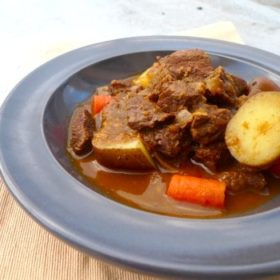
Indian Brown Beef Stew Recipe
Ingredients
- 3 tablespoons canola oil
- 1 large onion finely chopped (about 2 cups)
- 2 tablespoons coriander seeds finely ground
- 2 teaspoons finely grated garlic (about 4 large cloves)
- 1 teaspoon finely grated fresh ginger (about 2-inch piece)
- 1 teaspoon cayenne
- 1/2 teaspoon ground turmeric
- 1 pound beef sirloin cut into 1-inch square pieces
- 2 cups water
- 1 1/2 teaspoons salt
- 2 large russet potatoes (about 1 pound), cut into 2-inch cubes
- 1 mediium green serrano chile cut lengthwise in quarters
- 1 tablespoon rice vinegar or apple cider vinegar
Instructions
- Heat the oil in a large stockpot and sauté the onion until golden. Add the coriander, garlic, ginger, cayenne, and turmeric, and stir over medium heat until browned, about 4 minutes. Deglaze the pan by adding a few tablespoons of water and using a spatula to loosen the browned bits, if the mixture starts sticking to the bottom.
- Add the beef and sauté over medium heat until well browned, 5 to 10 minutes. Add the 2 cups water and salt and bring to a boil. Reduce the heat to a simmer and cook, covered, for 1 hour. Add the potatoes and chile and continue cooking until the beef and potatoes are tender, another 15 to 20 minutes.
- Add the vinegar, simmer for an additional 2 minutes, and remove from the heat. Serve hot with crusty bread or steamed white rice.
Nutrition
This content was originally posted on FearlessFresh.com.

